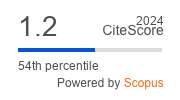Ali decentralizirano upravljanje prinaša manj znanstvenih rezultatov? Kvalitativna komparativna analiza (fsQCA) fiskalne decentralizacije in odločilni dejavniki nacionalne inovacijske zmožnosti
DOI:
https://doi.org/10.4335/15.3.647-668(2017)Ključne besede:
nacionalni inovacijski sistemi, QCA, inovacijska politika, fiskalna decentralizacijaPovzetek
V prispevku zagovarjamo stališče, da je nacionalna inovacijska infrastruktura tesno povezana z znanstvenimi rezultati in da lahko nekateri drugi dejavniki, kot je decentralizirano upravljanje, v določenih kombinacijah z inovacijsko infrastrukturo prinesejo več znanstvenih rezultatov. To prikažemo z uporabo metode kvalitativne komparativne analize fsQCA za analiziranje podatkov o nacionalnih inovacijskih kapacitetah, fiskalni decentralizaciji in rezultatih znanstvene politike. Izsledki potrjujejo, da čeprav je nacionalna inovacijska infrastruktura potreben pogoj za uspešne znanstvene rezultate, pa decentralizacija v določenih, a ne vseh primerih vodi v uspešne znanstvene rezultate in da se poti do uspešnih znanstvenih rezultatov razlikujejo med različnimi državami.
Literatura
Allen, M. M. C., & Aldred, M. L. (2011) Varieties of capitalism, governance, and high-tech export performance: A fuzzy-set analysis of the new EU member states, Employee Relations, 33(4), pp. 334–355.
Abdel Latif, L., Martinez-Vazquez, J. & Musharraf R. C. (2013) Is fiscal decentralization harmful to business climate? (Georgia: International Center for Public Policy Andrew Young School of Policy Studies, Georgia State University).
Asheim, B.T. & Coenen, L. (2005) Knowledge bases and regional innovation systems: Comparing Nordic clusters, Research Policy, 34, pp. 1173-1190.
Bathelt, H., Malmberg, A. & Maskell, P. (2004) Clusters and knowledge: Local buzz, global pipelines and the process of knowledge creation, Progress in Human Geography, 28(1), pp. 31-56.
Blöchliger, H. & Égert, B. (2013) Decentralisation and Economic Growth - Part 2: The Impact on Economic Activity, Productivity and Investment. In: OECD Working Papers on Fiscal Federalism, No. 15 (Paris: OECD Publishing).
Cankar, F., Deutsch, T., Zupan, B. & Setnikar Cankar, S. (2013) Schools and promotion of innovation, Hrvatski časopis za odgoj i obrazovanje, 15(Sp. Ed. 2), pp. 179-211.
Edquist, C. (2001) The Systems of Innovation Approach and Innovation Policy: An account of the state of the art, paper presented at DRUID Conference Aalborg, Retrieved from http://www.druid.dk/uploads/tx_picturedb/ds2001-178.pdf.
Edquist, C. (2011) Systems of innovation: Perspectives and Challenges, African Journal of Science, Technology, Innovation and Development, 2(3), pp. 14-43.
European Commission (2010) Europe 2020. A strategy for smart, sustainable and inclusive growth (Brussels: European Commission).
Feld, L.P., Kirchgassner, G. & Schaltegger, C.A. (2004) Fiscal federalism and economic performance: Evidence from Swiss cantons (Marburg: Philipps-Universität).
Filippetti, A. & Cerulli, G. (2015) Are Decentralized Regions Ruled Better? Evidence from European Regions Using a Dose-Response Approach, available at: http://ssrn.com/abstract=2668563 (January 10, 2017).
Filippetti, A. & Sacchi, A. (2016) Decentralization and economic growth reconsidered: The role of regional authority, Environment and Planning C: Government and Policy, 34(8), pp. 1793-1824.
Fiss, P. C. (2011) Building better causal theories: a fuzzy set approach to typologies in organization research, Academy of Management Journal, 54(2), pp. 393–420.
Fiss, P. C. (2012) Using Qualitative Comparative Analysis (QCA) and Fuzzy Sets (Los Angeles: University of Southern California).
Freeman, C. (1987) Technology Policy and Economic Performance (London: Pinter).
Furman, J. L., Porter, M. E., & Stern, S. (2002) The determinants of national innovative capacity, Research Policy, 31(2002), pp. 899–933.
Guimon, J. (2013) Smart Decentralization of Innovation Policies (Washington: World Bank).
Kreiman, G., & Maunsell, J. H. R. (2011) Nine criteria for a measure of scientific output, Frontiers in Computational Neuroscience, 5(48), pp. 1-6.
Likar, B., Cankar, F. & Zupan, B. (2015) Educational model for promoting creativity and innovation in primary schools, Systems research and behavioral science, 32(2), pp. 205-213.
Lin, G. T. R., Shen, Y.-C., & Chou, J. (2010) National innovation policy and performance: Comparing the small island countries of Taiwan and Ireland, Technology in Society, 32(2), pp. 161–172.
Martinez-Vazquez, J., Lago-Peñas, S. & Sacchi A. (2016) The impact of fiscal decentralization: a survey, Journal of Economic Surveys, forthcoming, https://doi.org/10.1111/joes.12182.
Mason, C. & Brown, R. (2013) Creating good public policy to support high-growth firms, Small Business Economics, 40(2), pp. 211-225.
McCann, P. & Ortega-Argilés, R. (2013) Modern regional innovation policy, Cambridge Journal of Regions, Economy and Society, 9(3), pp. 125-138.
Metcalfe, S. (1995) The Economic Foundations of Technology Policy: Equilibrium and Evolutionary Perspectives. In Stoneman P. (ed.), Handbook of the Economics of Innovation and Technological Change (Oxford (UK)/Cambridge (US): Blackwell Publishers).
OECD (1997) Diffusing Technology to Industry: Government Policies and Programmes (Paris: OECD Publishing).
OECD (2011) Regions and Innovation Policy (Paris: OECD Publishing).
OECD (2013) Science, Technology and Industry Scoreboard, https://doi.org/http://dy.doi.org/10.1787/sti_scoreboard-2013-en.
Pustovrh, A. & Jaklič, M. (2014) National Innovation Policies in the EU: A Fuzzy-Set Analysis, Economic and Business Review, 16(1), pp. 39-62.
Ragin, C. C. (1987) The comparative method (Oakland: University of California Press).
Ragin, C. C. (2000) Fuzzy-set social science (Chicago: University of Chicago Press).
Ragin, C. C., Kriss, A. D., & Davey, S. (2006) Fuzzy-Set/Qualitative Comparative Analysis 2.0. (Tuscon, Arizona: University of Arizona, Department of Sociology).
Ragin, C. C., & Rihoux, B. (2009) Configurational Comparative Methods (Thousand Oaks: Sage).
Rihoux, B., & Grimm, H. (2006) Innovative Comparative Methods for Policy Analysis, available at: http://www.google.si/books?id=pTM6yOvT-6UC&dq=quantitative+methods+innovation+policy&lr=&source=gbs_navlinks_s (December 14, 2016).
Rodríguez-Pose, A. & Ezcurra, R. (2011) Is fiscal decentralization harmful for economic growth? Evidence from the OECD countries, Journal of Economic Geography, 11(4), pp. 619-643.
Schneider, A. (2003) Decentralization: Conceptualization and measurement, Studies in Comparative International Development, 38(3), pp. 32-56.
Schneider, C. Q., & Wagemann, C. (2012) Set-theoretic Methods for the Social Sciences (Cambridge: Cambridge University Press).
Strump, K. S. (2002) Does Government Decentralization Increase Policy Innovation?, Journal of Public Economic Theory, 4(2), pp. 207-241.
Treisman, D. (2002) Defining and Measuring Decentralization : A Global Perspective. Unpublished Manuscript, (March 2002), available at: http://www.sscnet.ucla.edu/polisci/faculty/treisman/Papers/defin.pdf (November 20, 2016).
Tödtling, F. & Trippl, M. (2011) Regional innovation systems, In: Cooke, P., Asheim, B., Boshma, R., Martin, R., Schwartz, D. & Tödtling, F. (eds.) The Handbook of Regional innovation and Growth (Cheltenham: Edward Elgar).








